Who Controls the User Experience? AMD’s Carrizo Thoroughly Tested
by Ian Cutress on February 4, 2016 8:00 AM ESTBenchmark Results: Professional and OpenCL
Here are our results from our Professional and OpenCL tests. A reminder of our systems, including their graphics:
| System Overview | ||||
| µArch | APU + GPU | Memory | Channel | |
| HP Elitebook 745 G2 | Kaveri | A10 PRO-7350B (19W) R6, 384 SPs, 533 MHz |
8 GB | Dual |
| HP Elitebook 745 G3 | Carrizo | PRO A12-8800B (15W) R7, 512 SPs, 800 MHz |
4 GB | Single |
| Toshiba Satellite E45DW-C4210 |
Carrizo | FX-8800P (15W) R7, 512 SPs, 800 MHz |
8 GB | Single |
| HP Pavilion 17z-g100 |
Carrizo | A10-8700P (15W) R6, 384 SPs, 800 MHz |
8 GB | Single |
| Lenovo Y700 | Carrizo | FX-8800P (15W) R7, 512 SPs, 800 MHz R9 385MX, 512 SPs, 900-100 MHz |
16 GB | Single |
PCMark 08
PCMark08, developed by Futuremark, is a simple press play and run benchmarking tool designed to probe how well systems cope with a variety of standard tasks that a professional user might encounter. This includes video conferencing with multiple streams, image/file manipulation, video processing, 3D modelling and other tools. In this case we take the three main benchmark sets, Creative, Home and Work, and run them in OpenCL mode which aims to take advantage of OpenCL accelerated hardware. For fun we also put in the PCMark08 Storage workset.
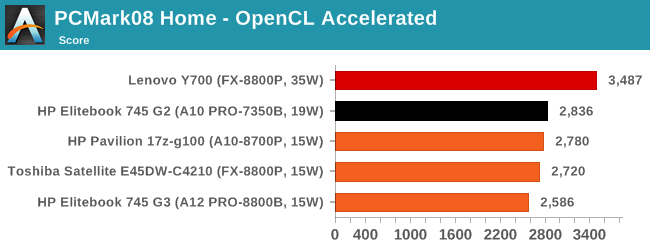
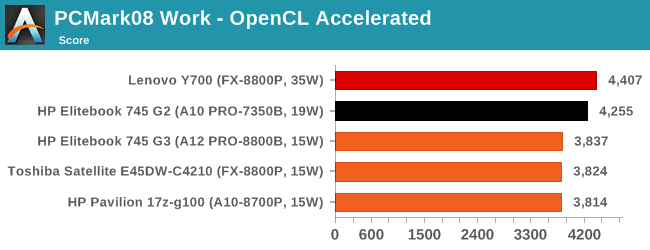
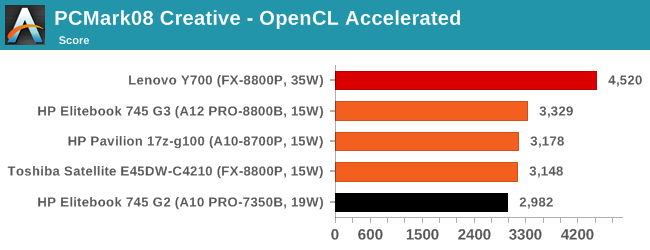
Both of the Home and Work tests show something starteling in the Kaveri system beating all the 15W Carrizo parts. This comes back to what we saw on WebXPRT on the last page – these workloads are very bursty in nature, requiring the system to wake up, run a small amount of work, and go back to sleep. It would seem that this requires a lot more effort from the Carrizo platforms than the Kaveri ones (perhaps by nature of the lower idle power draw starting point on Carrizo) which impacts time critical performance metrics.
If we take the CPU frequencies of the two Elitebook systems, starting with the 745 G2 (Kaveri)
Here the standard frequency tends to be in the 3300 MHz region, moving down to lower frequencies when more threads are needed. But for the 745 G3 (Carrizo):
Here the CPU frequency is obviously mostly at the 2500 MHz mark, sometimes bursting up to 3400 MHz (It’s actually more of a 2:1 split in favor of 2500 MHz).
You might argue that the temperature of the design might be to blame. Both Elitebooks are in the same chassis, so let us see:
(take note of the scales)
Here it shows the G2 wanting to stay below 60C, whereas the G3 is happy to go almost to 80C, albeit with an average temperature which is nearer 50C. This means that the G2 can arguably keep the higher frequencies for longer.
Just to weigh in on the other 15W Carrizo designs in the Toshiba Satellite and HP Pavilion:
In both cases, similar to the G3, the main frequency for the test is actually the lower 2500/2300 frequency, with the system moving up to the higher frequency state around a third of the time, rather than staying at the higher state and moving back down. This is what is causing the Kaveri system to win out in these sorts of workloads (though likely at a power penalty).
On the storage front, having a mechanical drive is a killer here.

Agisoft Photoscan
Photoscan is professional software that takes a series of 2D images (as little as 50, usually 250+) and 'performs calculations' to determine where the pictures were taken and if it can create a 3D model and textures of what the images are of. This model can then be exported to other software for touch-ups or implementation in physics engines/games or, as the reader that directed me to it, national archiving. The tool has four phases, one of which can be OpenCL accelerated, while the other three are a mix of single thread and variable thread workloads. We ran the tool in CPU only and OpenCL modes.
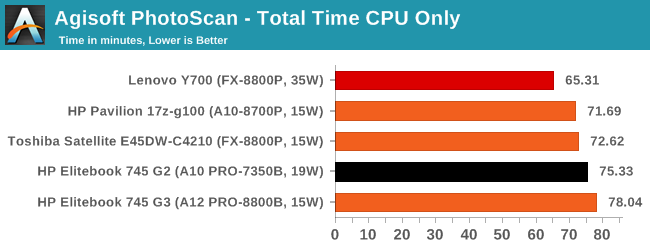
When pure CPU performance matters, having the higher thermal headroom matters most. But moving it to the OpenCL mode shows that those extra TDP points can matter a lot on load balancing:
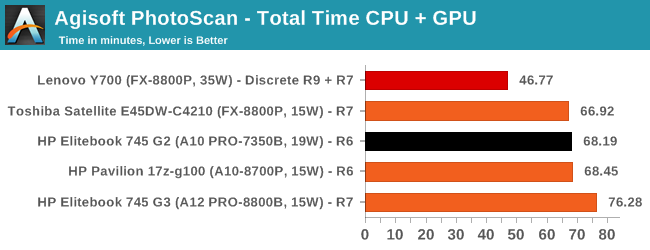
There are two things to note here. One, something seems to have gone very wrong with the G3, and I’m sure those numbers are erroneous and need to be re-run or the 4GB of memory is actually a hindrance here. The second is that the combination R7/R9 graphics in the Lenovo, despite not being in Crossfire, can both be used in OpenCL mode. This pushes a speed up of almost 30%.
Linux Bench
Linux Bench is a collection of Linux based benchmarks compiled together by ServeTheHome. The idea for this is to have some non-windows based tools that are easy enough to run with a USB key, an internet connection and three lines of code in a terminal. The tests in Linux Bench include standard synthetic compute, compression, matrix manipulation, database tools and key-value storage.
Unfortunately Linux Bench refused to run on any of the HP systems for relatively unknown reasons – the fact that it was all the HP models perhaps means that there is something firmware related which is causing the LiveCD to not boot properly. Nonetheless, the results are here for completeness.
| Linux Bench | ||
| Toshiba Satellite E45DW-C4210 (15W) |
Lenovo Y700 (35W) |
|
| C-Ray Hard Test / seconds | 365 | 267 |
| 7-Zip Compression MIPS | 5718 | 6110 |
| 7-Zip Decompression MIPS | 7320 | 9733 |
| NAMD (steps per time) | 1.72 | 2.46 |
| NPB MOPS (per sec per thread) | 365 | 321 |
| OpenSSL Sign | 220 | 296 |
| OpenSSL Verify | 13518 | 19465 |
| Redis 1 | 13210 | 12034 |
| Redis 10 | 41494 | 38760 |
| Redis 100 | 33445 | 31949 |






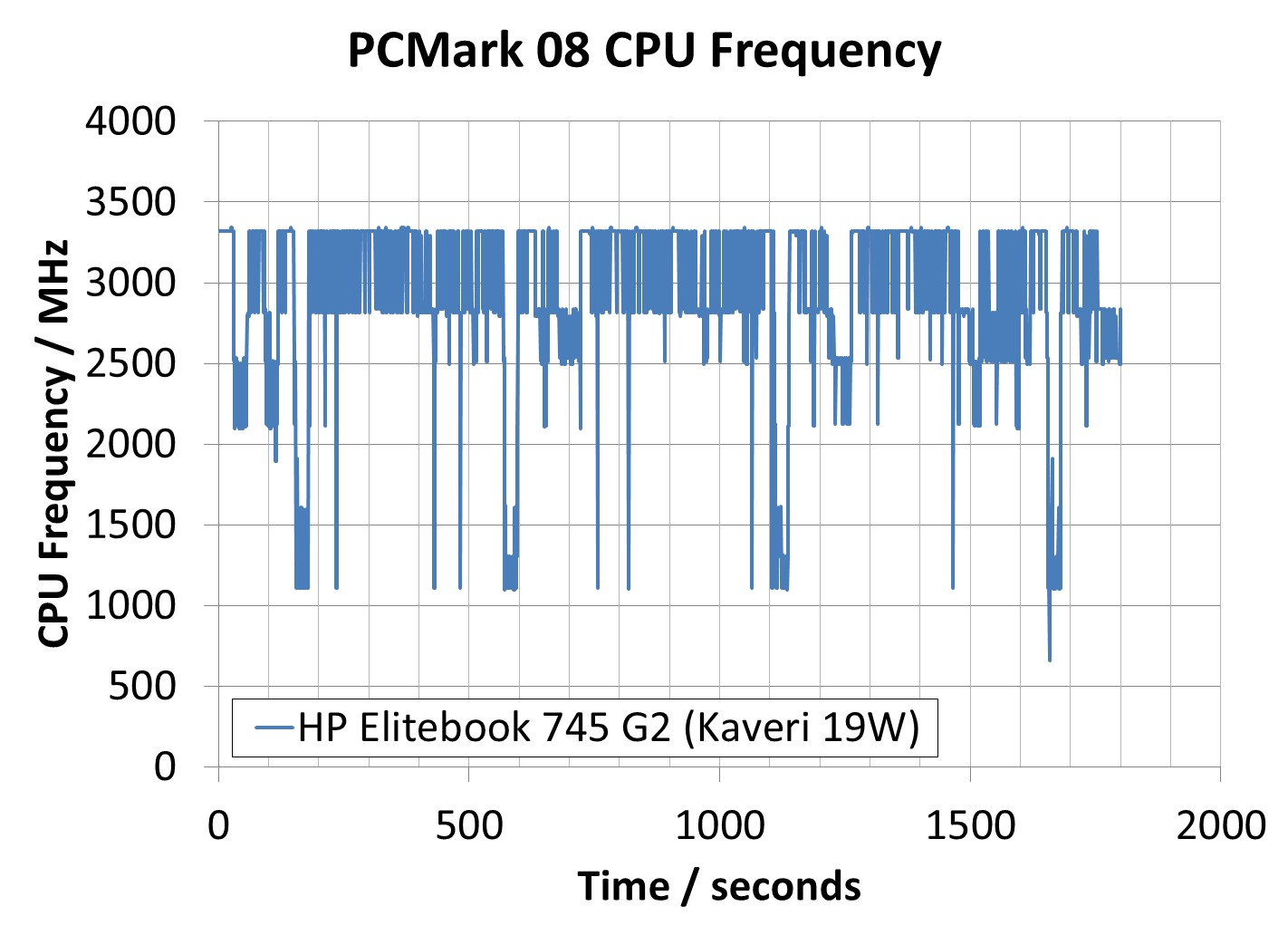

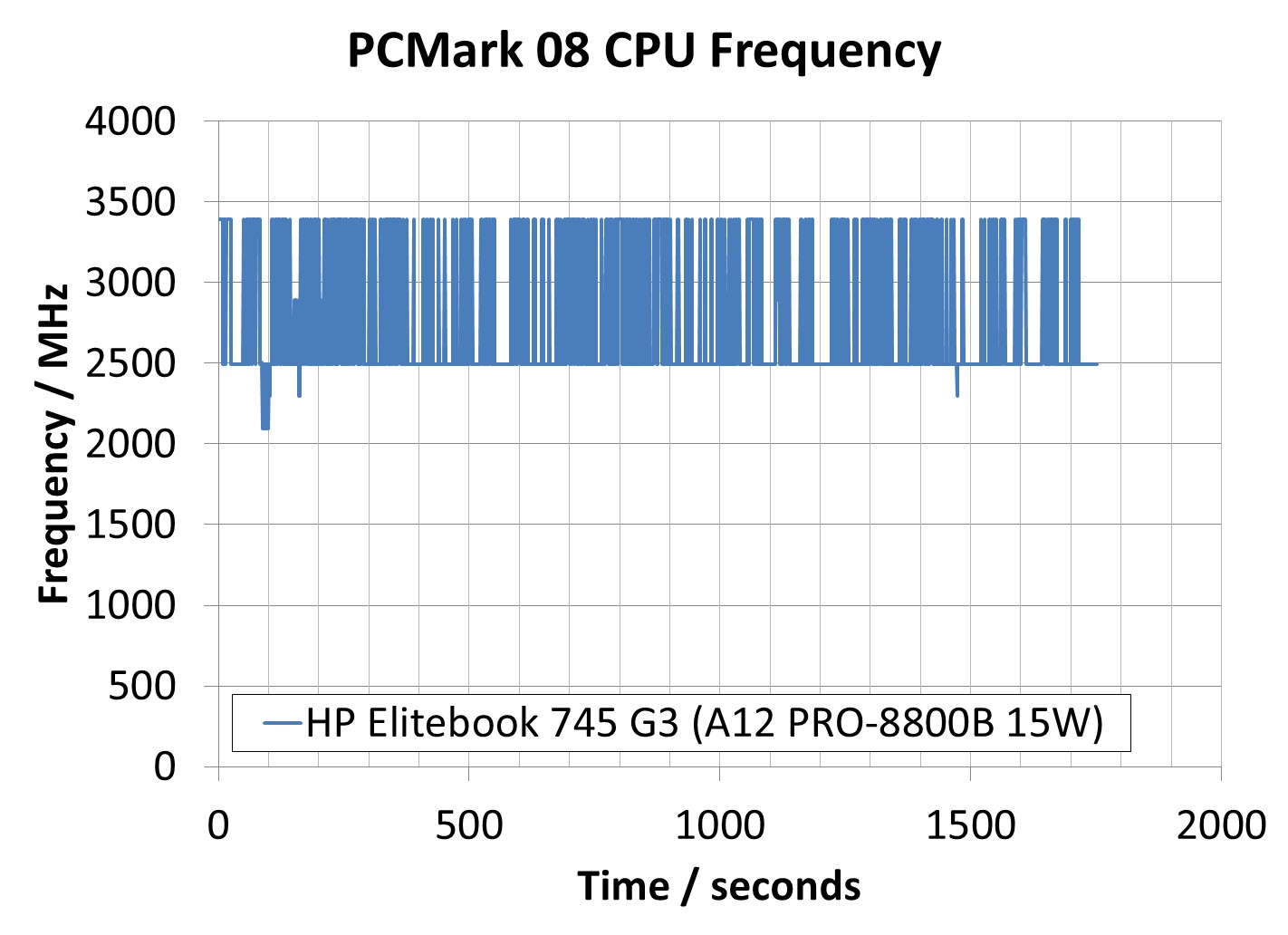
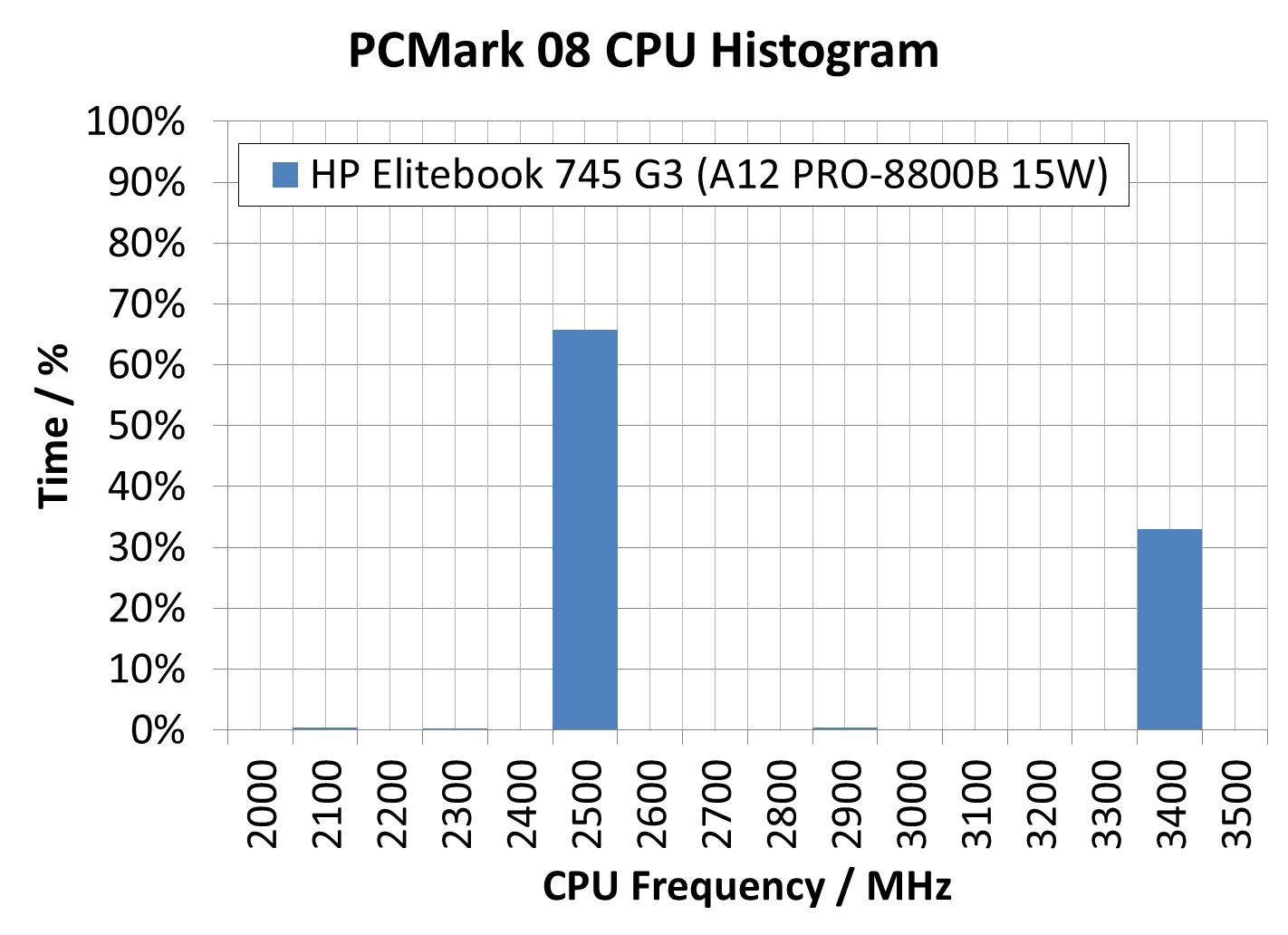

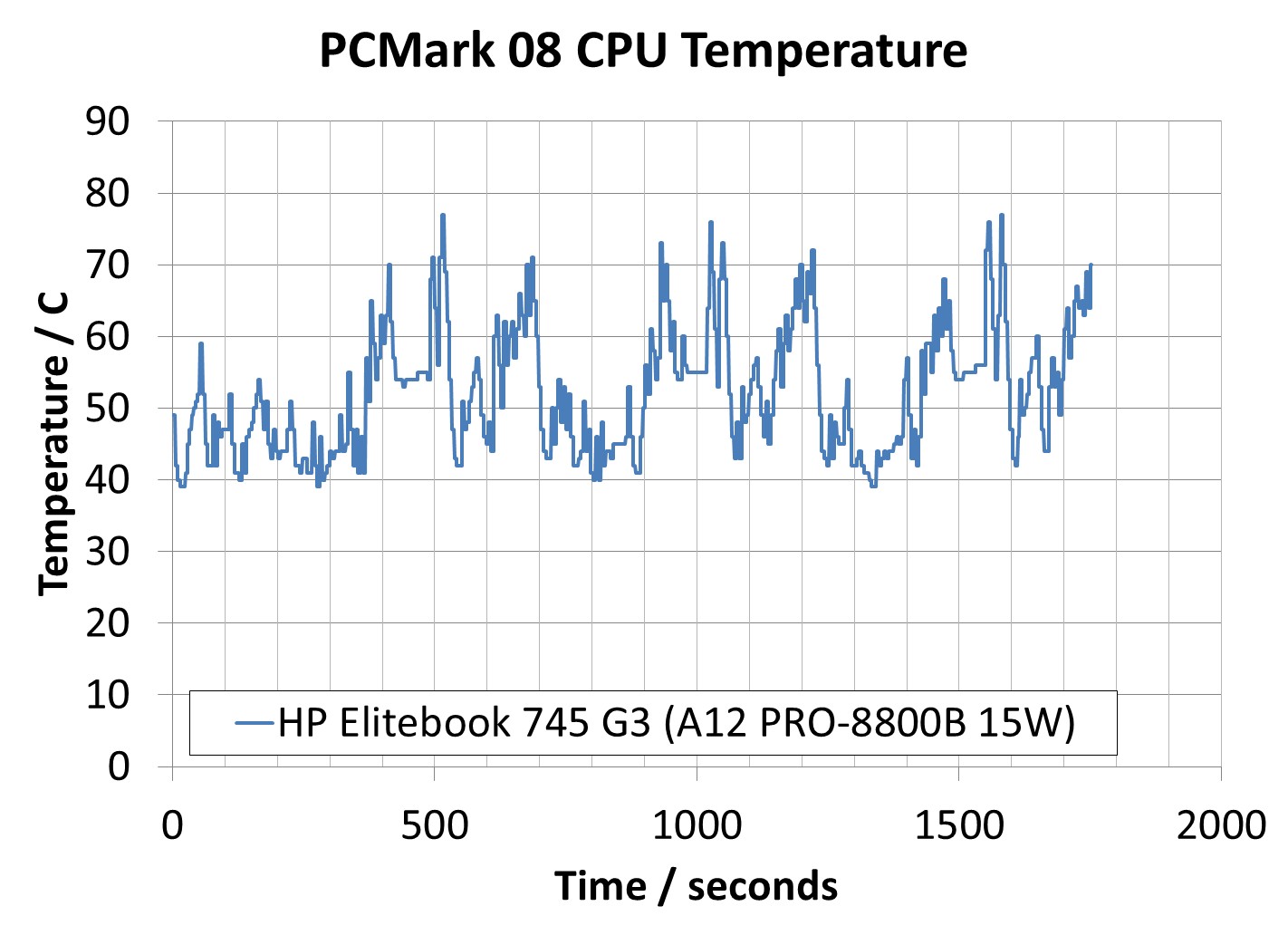










175 Comments
View All Comments
chris471 - Friday, February 5, 2016 - link
What do you do with all those split hares? Are they any good barbecued?("Octane splits hares between the Kaveri ...")
Ian Cutress - Friday, February 5, 2016 - link
Lightly roasted for me :) Edited, thanks!maglito - Friday, February 5, 2016 - link
Were you able to test 18Gbps HDMI? The ability to drive an external display with 2160p 4:2:2 @ 60Hz? I guess the lack of a 10bit accelerated video decoder almost makes the point moot for future 2160p content though....Otherwise, fantastic article!
MonkeyPaw - Friday, February 5, 2016 - link
Last time I shopped for a laptop (which was recently), I was considering an A10-based HP with a 1080p screen. The problem I saw was in reviews the battery life was really poor. It looked like HP put a small battery in it, making the thing only worthy as a DTR. I ended up going with a Lenovo with an i3. I guess part of the problem is that there are so many variants of laptops that finding a review of a specific model is impossible, and all you have to go on are things like Amazon or Best Buy ussr reviews, which can be extremely painful to read.Lolimaster - Friday, February 5, 2016 - link
HP sometimes release near "nice" AMD laptops but always cripples it with laughable battery capacities, same models intel inside dont get the nerfs.euskalzabe - Friday, February 5, 2016 - link
That was a wonderful article that I thoroughly enjoyed reading to start my Friday. Long story short, you perfectly define my laptop buying rationale with "SSD, dual channel memory, 8 hours+ light battery, under 2kg, Full HD IPS panel".That's why I bought an i5 UX305. I wanted an AMD machine because I plain like the company and would like them to succeed to bring more competition to Intel, but I found NOTHING even close to the specs you mentioned. The UX305 fit the description perfectly and cost me $750. It was an immediate purchase for me. If AMD managed the OEM relationship to create such a machine, it would be an insta-buy for me. Also, Zenbooks with Zen APUs oculd be a great marketing strategy :)
Shadowmaster625 - Friday, February 5, 2016 - link
AMD is a company that shoots itself in the foot at every opportunity. I am truly perplexed. Their cat cores shouldnt even exist. But not only do those crippled parts exist, they crippled their premium parts by combining the two platforms! WHY? How could they not see that every notebook would be single channel? They wasted the entirety of their ATI purchase, as you can see with the Rocket League results vs Intel. This is a disgrace.AMD needs to realize that it IS AMD who controls the User experience. Look at the Mackbook Air. Look at the Surface Pro. Look at the Playstation 4 and Xbox One. All of these platforms have a set minimum level of performance. Sure they might be more expensive than a $300 atom clunker, but at least the user will not throw the thing out the window after pulling their hair out.
AMD needs to put a floor under their products. 4 cores. 8GB of unified HBM. 512 cores GPU. This is the SoC that they need. Sure they can fuse off a core or whatever to harvest bad dies, but this is the minimum die they should be making. Ideally within 2 years they will move to a 4 core, 16GB HBM, and they will replace one stack of HBM with 128GB of HBF. They need to control the memory bandwidth of their SoC. Take away the ability of the OEMs to cripple performance. Use HBF to take away the ability for OEMs to cripple storage performance also. Do this, and every AMD system will be fast. And it will get design wins.
t.s - Friday, February 5, 2016 - link
If you read the article: AMD not crippled their premium parts. It was OEM. If only OEM create mobos that have dual channel mems.xthetenth - Friday, February 5, 2016 - link
OEMs shaving pennies is as universal a phenomenon as gravity, and designs should be made as such.t.s - Thursday, February 11, 2016 - link
hence the title, "who controls user experience" :)